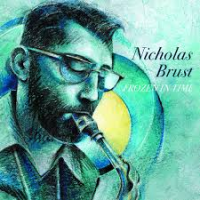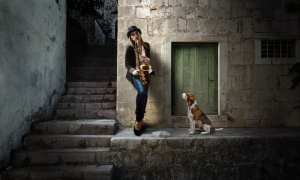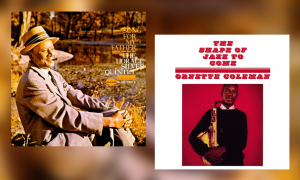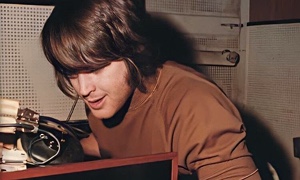Home » Jazz Articles » Building a Jazz Library » Yusef Lateef: An Alternative Top Ten Albums Blowing Cult...
Yusef Lateef: An Alternative Top Ten Albums Blowing Cultural Nationalism Out Of The Water

Courtesy Stephane Allaman
I believe each culture has some knowledge. That's why I studied with Saj Dev, an Indian flute player. That's why I studied Stockhausen's music. The pygmies' music of the rain forest is very rich music. The knowledge is out there. I believe one should seek knowledge from the cradle to the grave.
—Yusef Lateef
Lateef was born in Chattanooga, Tennessee. When he was five, his family moved to Detroit, where he began his career playing in swing bands in the early 1940s. Lateef toured with Dizzy Gillespie's Afro-Cuban ensemble in 1949 and started leading his own bands in and around Detroit in the early 1950s. He began recording for Herman Lubinsky's Newark, New Jersey label, Savoy, in 1957, with his culturally inclusive aesthetic and use of "exotic" instruments already in place. Lateef's breakthrough album was Eastern Sounds, on the Prestige subsidiary, Moodsville, in 1961.
Like Rahsaan Roland Kirk (related), who also emerged on record in 1957, Lateef was regarded by an uptight jazz establishment as, at best, a maverick of little consequence, or, at worst, a charlatan. His mid 1950s adoption of an Islamic name (he was previously known as Bill Evans) and use of non-European instruments were dismissed as attention-seeking gimmicks.
As a consequence, Lateef was sidelined by most mainstream critics and has been relegated to a footnote in virtually every historical survey of the music that has been published. A particularly egregious example is Ashley Kahn's The House That Trane Built: The Story Of Impulse Records (Granta, 2006). Lateef is mentioned only in passing despite recording half a dozen excellent albums for the label during its mid-1960s belle epoque.
So let us get one thing out of the way right now. Lateef was no dilettante musician hiding technical inadequacies or a weak grasp of the jazz tradition behind a veneer of exoticism. He was a master of straight-ahead jazz and embraced other cultural traditions in order to extend his vocabulary. Anyone doubting Lateef's talent as a steaming hard-bop tenor saxophonist should be directed towards the YouTube clip below and some of the albums in this Alternative Top Ten.
Happily, Lateef's greatness began to be widely championed in the mid 2000s. In the US, he received a lifetime Jazz Master Fellowship Award from the National Endowment for the Arts in 2010. In Britain, he is regarded as a hero and role model on the alternative jazz scene which began to emerge in London around 2015. The world has begun catching up with Lateef, who passed in 2013, aged 93 years.
This Alternative Top Ten omits Lateef's most celebrated albums in favour of lesser known but equally outstanding releases. Eastern Sounds is excluded as are all of his Impulse! releases and all fifteen of the love 'em or loathe 'em rhythm 'n' blues-infused albums he released on Atlantic from 1967-1976. Some sideman albums are included, though not high profile titles such as those Lateef made as a member of Cannonball Adderley's band in the early 1960s. Also excluded, Randy Weston's Uhuru Afrika (Roulette, 1960), Charles Mingus' Pre-Bird (Mercury, 1960) and Clark Terry's Color Changes (Candid, 1961). All three of these discs deserve to be in any decent jazz library but do not feature quite enough Lateef to be included here.
Also excluded are the several dozen increasingly new-ageish albums Lateef released on his own YAL label from the early 1990s onwards, other than an irrefutably hard-core jazz album he made with Archie Shepp in 1992.
Hopefully, you will find one or two items that have so far slipped under your radar....
 Yusef Lateef
Yusef LateefJazz Mood
Savoy, 1957
On this 1957 debut, Lateef takes jazz into cultural orbits that would only be widely explored by other artists in the wake of John Coltrane's 1961 albums Olé (Atlantic) and Africa/Brass (Impulse!). The album also anticipates Dave Brubeck's experiments with unusual time signatures on Time Out (Columbia, 1959). On Jazz Mood, Lateef plays tenor saxophone, flute and argol, bassist Ernie Farrow (Alice Coltrane's big brother) also plays rabab (Afghani lute), and trombonist Curtis Fuller gets nimble with the Turkish finger cymbals. The band is completed by pianist Hugh Lawson and drummer Louis Hayes. All five tunes are Lateef originals. Opener "Metaphor" is an argol and tenor feature. "Yusef's Mood" is a stomping tenor-led blues. Orientalist "The Beginning" is in 7/4 time. "Morning" showcases the rabat. Closer "Blues In Space" is a Maghrebi blues with Lateef on flute.
 Yusef Lateef
Yusef LateefPrayer To The East
Savoy, 1957
Prayer To The East was recorded a few months after Jazz Moods with two changes to the lineup. Hugh Lawson and Ernie Farrow return, while Curtis Fuller is replaced by flugelhornist Wilbur Harden and drummer Louis Hayes by Oliver Jackson. Savoy's Ozzie Cadena is once more the sympatico producer. This time the set list includes only one Lateef original ("Endurance"), but the other four tunes are well chosen and the vibe of the earlier album is sustained. The Middle Eastern ambiance of Dizzy Gillespie's "A Night In Tunisia" is enhanced by Lateef's argol. The flute showcase "Prayer To The East" was written by Oliver Jackson's brother, the bassist Ali Muhammad Jackson, who also arranged exotica composer Les Baxter's "Love Dance." The closer is Ram Ramirez's "Lover Man," which features Lateef's tenor in sumptuous balladic mode. Lawson and Harden contribute elegantly soulful solos throughout. Another killer album.
 Yusef Lateef
Yusef LateefBefore Dawn: The Music Of Yusef Lateef
Verve, 1958
On Before Dawn, Lateef's only Verve release, producer Norman Granz tilts the trajectory a little closer to the mainstream, his own centre of gravity. The band is an amalgam of the two earlier Savoy lineups. Mainly playing tenor, Lateef is rejoined by Curtis Fuller, Hugh Lawson (this time on celeste as well as piano), Ernie Farrow (again on bass and rabab) and Louis Hayes. With the exception of Charlie Parker's "Constellation," all eight tracks are Lateef originals, but with a pronounced bop-going-on-hard-bop feel. The album kicks off in stomping mode with "Passion," then slows right down with the ballad "Love Is Eternal." The Parkerish "Pike's Peak," based like so many of Parker's own tunes on "What Is This Thing Called Love," re-establishes an up-tempo pace. A slightly more conventional album than usual, but a great one nonetheless.
 Yusef Lateef And His Jazz Quartet
Yusef Lateef And His Jazz QuartetThe Dreamer
Savoy, 1959
The Dreamer finds Lateef back on Savoy with Ozzie Cadena but with a new quintet: Bernard McKinney (later a.k.a. Kiane Zawadi) on euphonium, Terry Pollard on piano, William Austin on bass and Frank Gant on drums. McKinney's grasp of contrapuntalism and Pollard's funkiness are notable features of the album. After the opener, the Lateef original "Oboe Blues," Lateef switches to flute on Matthew Loveland's "Angel Eyes," then focuses on tenor and argol for the rest of the set. On the explorative "The Dreamer," the band alternate between an eight to the bar Latin beat and straight-ahead, cooking, hard bop. The album closes with Jerome Kern's "Can't Help Lovin' That Man," a vehicle for Lateef's lush tenor. (Interestingly and not necessarily coincidentally, at a time when women musicians were still much under-represented in jazz, Pollard preceded another Detroit pianist, Alice Coltrane, in having an early break with vibraphonist Terry Gibbs, with whom she began playing in 1951).
 Yusef Lateef
Yusef LateefThe Centaur And The Phoenix: The Big Sound Of Yusef Lateef
Riverside, 1960
On The Centaur And The Phoenix, Lateef's first album with an expanded lineup, he added the European classical tradition to his cultural mix with the angular, Stravinsky-esque title track and the lovely "Summer Song." Both were adapted by composer Charles Mills from his symphonic scores. The nonet includes trumpeters Clark Terry and Richard Williams, Curtis Fuller, baritone saxophonist Tate Houston and bassoonist Josea Taylor. The pianist is Joe Zawinul, with whom Lateef was soon to reunite in Cannonball Adderley's band. Another significant contributor is Kenny Barron, who wrote the opening track and arranged others. As a keyboard player, composer and arranger, Barron would play an important role in Lateef's Joel Dorn-produced Atlantic albums between 1967 and 1976.
 Curtis Fuller
Curtis FullerBoss Of The Soul-Stream Trombone
Warwick, 1961
Boss Of The Soul-Stream Trombone is one of a handful of high-grade hard bop albums released by the shortlived New York indie Warwick, whose best-selling act was rock 'n' roll combo Johnny & The Hurricanes. By now, Lateef and Curtis Fuller were familiar studio partners, but the triple-horn frontline is completed by a new name, trumpeter Freddie Hubbard, hot on the back of his 1960 Blue Note debut, Open Sesame. Ostensibly a Fuller album, the main soloists are actually Lateef and Hubbard, both on cracking form. After Hubbard went mega, the album was reissued under his name by a succession of dodgy labels as Gettin' It Together.
 Art Blakey And The Afro-Drum Ensemble
Art Blakey And The Afro-Drum EnsembleThe African Beat
Blue Note, 1962
Made without the Jazz Messengers, The African Beat is a celebration of jazz's African roots (as every Art Blakey album was to some extent). Almost inseparable at this time, Lateef and Curtis Fuller are teamed up again, although Fuller plays timpani rather than trombone. Ahmed Abdul-Malik, a bassist with a cultural outlook similar to Lateef's, is also present along with six more West African and African American hand drummers and percussionists. Notable among them are Chief Bey, Garvin Masseaux and Solomon Ilori, whose 1963 Blue Note album African High Life features much the same cast of hand drummers and percussionists (and Abdul-Malik). Lateef is the solo horn player and is heard on tenor, oboe, flute, cow horn and mbira. Bey, Garvin and Ilori are the composers of six of the seven tracks, with Ghanaian master drummer Guy Warren (unfortunately not present at the session) contributing the seventh. A more cohesive and better realised set than both Blakey's Orgy In Rhythm (Blue Note, 1957) and Holiday For Skins (Blue Note, 1959) and a fine platform for Lateef.
 A.K. Salim
A.K. SalimAfro-Soul / Drum Orgy
Prestige, 1965
A little known item in Lateef's discography, composer and arranger Ahmad Khatab Salim's Afro-Soul / Drum Orgy is similar in intent to Art Blakey's The African Beat. The six-piece drums and tuned-percussion ensemble is augmented by Lateef on tenor, argol and flute, Sun Ra stalwart Pat Patrick on alto and baritone saxophones, and Johnny Coles on trumpet. The album has an edge on Blakey's by virtue of having half as many tracks, with the longer playing times allowing more immersive grooves to be developed. But from a Lateef collectors' point of view, his role as sole horn on the Blakey album gives that a different edge. Happily, both discs are worth checking out. (Lateef and Salim first met, virtually as it were, on the 1957 Savoy album Stable Mates, taking one side each with their own bands, with Lateef leading his Before Dawn lineup on side one).
 Yusef Lateef
Yusef LateefIn Nigeria
Landmark, 1985
From 1983 to 1986, Lateef lived in northern Nigeria, teaching jazz at Ahmadu Bella University and digging deep into traditional Hausa and Yoruba music. He made two albums with local drum and percussion groups: In Nigeria, which was recorded in Lagos, post-produced in New York and released on Riverside founder Orrin Keepnews' Landmark label; and Hikima (Creativity), which Lateef in effect self-released in 1984 through Ahmadu Bella's Centre for Nigerian Cultural Studies. On In Nigeria, a suite of seven originals, Lateef plays tenor, various European, African and Chinese flutes, a Hausa algaita (oboe) and leads a call-and-response vocal quintet. Hikima is as good as impossible to find. In Nigeria turns up occasionally, most often on YAL, on which it was reissued in 1995. Either album should be seized on sight.
 Yusef Lateef & Archie Shepp
Yusef Lateef & Archie SheppTenors Of Yusef Lateef And Archie Shepp
YAL, 1992
From the early 1990s onwards, most of Lateef's several dozen albums were released on his own YAL label and tend towards an increasingly new-age orbit which may or may not be to your taste. Among them, however, are four indisputably hard-core jazz albums which Lateef recorded with fellow tenors Archie Shepp, Von Freeman, Ricky Ford and Rene McLean. On the rough and tumble face-off which is Tenors Of Yusef Lateef And Archie Shepp , the two players are accompanied by pianist Tom McClung (who twenty years later was part of Shepp's Paris-based Attica Blues Orchestra), bassist Avery Sharpe and drummer Stephen McCraven. Adam Rudolph, a frequent collaborator with Lateef in the 1990s and 2000s, adds percussion to one track. The tunes, whose composer(s) are unknown but are probably all by Lateef, are homages to jazz greats, among them Thelonious Monk ("Monk Remembered") and Gene Ammons ("Ammons Remembered"). No prizes for working out who is paid tribute to on "Selim." A great place to end this survey, back where Lateef more or less began.
Tags
PREVIOUS / NEXT
Support All About Jazz
 All About Jazz has been a pillar of jazz since 1995, championing it as an art form and, more importantly, supporting the musicians who make it. Our enduring commitment has made "AAJ" one of the most culturally important websites of its kind, read by hundreds of thousands of fans, musicians and industry figures every month.
All About Jazz has been a pillar of jazz since 1995, championing it as an art form and, more importantly, supporting the musicians who make it. Our enduring commitment has made "AAJ" one of the most culturally important websites of its kind, read by hundreds of thousands of fans, musicians and industry figures every month.























